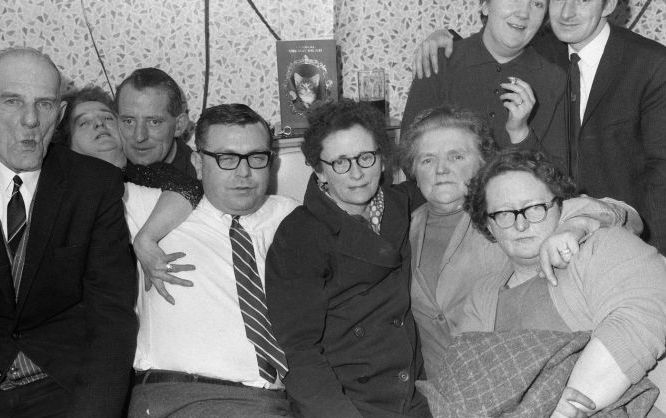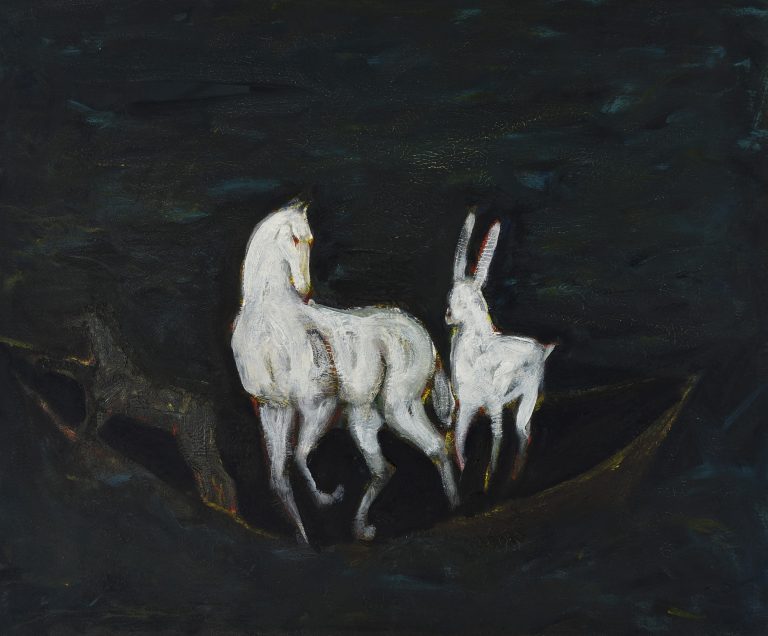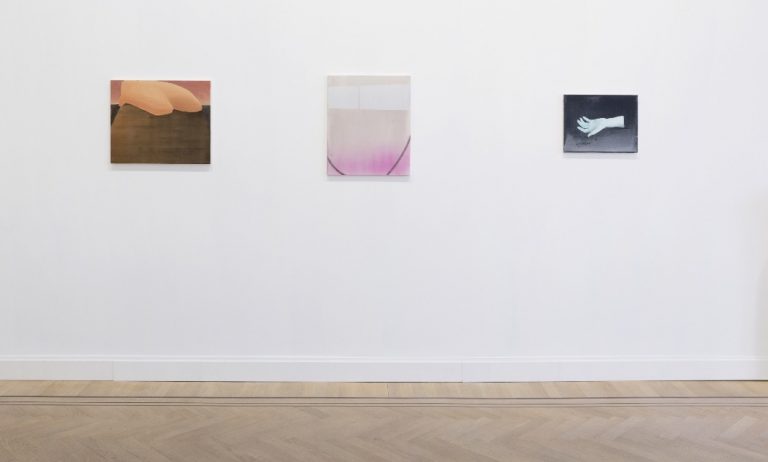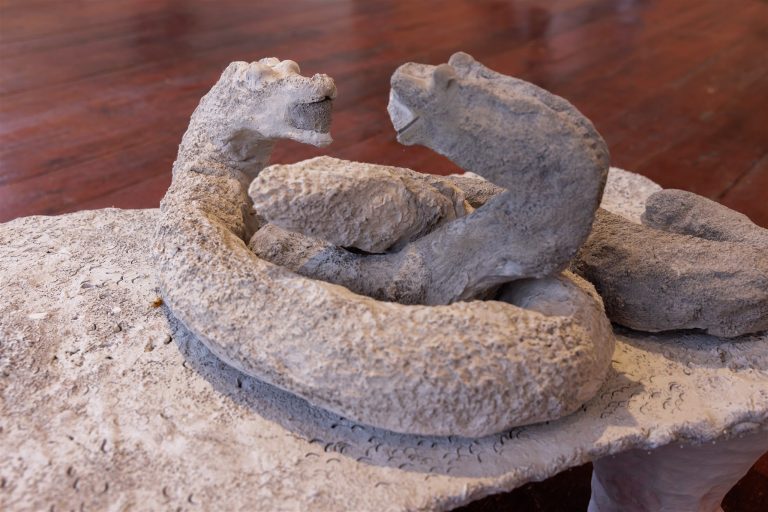… Is there any emotion more deeply philosophical than the one we experience as we anxiously wait – beneath that rather diabolical red light which turns a glowing cigarette into a green diamond – for the emergence to visibility of that mysterious latent image, on the exact nature of which Science has not yet made up its mind?
– Paul Valéry, The Centenary of Photography, 1939
Paul Valéry’s notion of photography as an anxious wait, a suspense between this world and an unknowable one to come, describes the charged sense of latency that is tensely visible in Dennis Dinneen’s photographs. Wishing to be recognised, recorded, catalogued, verified, Dinneen’s subjects are full of expectation – they are all waiting for the photograph to do something, to turn them into a fuller, more complete, maybe even transcendent version of who they already are. It is the mutual, contractual waiting – between photographer and subject, between instant of exposure and the looked-at photograph – that gives Dinneen’s images such power.

Untitled, from the series Small Town Portraits
Courtesy of the Dennis Dinneen Archive
The rediscovery of Dinneen’s photography, and the origins of the exhibition of his work at the Douglas Hyde Gallery, are down to the work of David J. Moore. Moore realised that the vast archive of images left behind by Dinneen was both an extraordinary act of social documentary and also, in effect, a long-term act of photographic art. Dinneen’s genius was capaciousness, his photographic studio in the back of his pub in Macroom serving as a departure lounge to the ‘visibility of [the] mysterious latent image’.[1]
The social world Dinneen’s images capture is a complex and shifting place. One might imagine that rural Ireland in the 1950s would be revealed as a highly structured society, restricted, regulated, and overseen by the moral influence of the church. There is, of course, ample evidence of this in the midst of these images, carefully curated as they are by Moore to highlight the range of Dinneen’s ‘studio’ portraits. For example, there is a first communicant here, bride of Christ, hands together in prayer and looking young and old at the same time. Her veil and lace gloves, her dress and handbag, are given the full glory of their whiteness by the sweeping black drape behind her that, accidentally, we assume, imitates the folds of a dress, as if some vast and tall black-cloaked entity towered over her, out of shot. And from behind that black velvet the image is interrupted by what becomes the signature element of Dinneen’s work in this exhibition – the extraneous, everyday background of his studio space – in this case, an armchair and patterned wallpaper.
The uncanniness of Dinneen’s uncropped images is particularly apparent in overtly religious images, or those in which religion as a marker of identity or a rite of passage is the event or characteristic to be memorialised. The kneeling choirboy, for example, starkly front-lit, rehearses a pose he has learnt for the occasion with intensity and concentration, his starched white linen glowing in contrast to the dinginess of the curtain behind him. The boy, or his parents, or Dinneen has chosen this posture of adoration as a gesture to an image they already know. Somehow it has led to the apparent disappearance of his knees and legs, which must be tucked behind him in some way, but make it appear as if he is floating just above the ground. In this posture is what many of Dineen’s sitters, and presumably Dinneen himself, imagine to be the power of the photograph – that it will commemorate and that it will distil, almost to an essence, the thing photographed.

Untitled, from the series Small Town Portraits
Courtesy of the Dennis Dinneen Archive
This desire, bordering on a belief that immortality is contained within the mystery of photography, is particularly compelling in these versions of Dinneen’s work because each image is bordered and framed by what is not meant to be included within it. The eternal remembrance that photography seems to offer reverberates out from the centre of each image to encompass the glimpses of banality that enter the image from the sides. So the photograph of a priest, looking stiff and uncomfortable, staring straight into the camera, is backdropped in white to offset his black clothing. As with many of these unsubtly lit images, his shadow is cast, firmly drawn, and close by, on the screen behind him. Properly cropped, this image is an identifier – a passport photo, a mug shot. But, expanded out, its perspectives multiply. The white backdrop is so intensely lit that its shape becomes a pure and unfathomable geometry, a receding or extruding column of light from above. And other either side of this, the room is reduced to abstract shapes and allegories – the doorway on the right-hand side of the sitter being akin to a metaphor of departure and passing on, and thus fitting to the profession of the man whose job is to mark the ushering in and out of individual lives.
If these religious figures (priest, choirboy, communicant) are what we might expect from post-war Macroom (at least in their socio-religious roles, if not in the resonances of the images Dinneen has made), then the cornucopia of other characters who crossed Dinneen’s threshold in search of the possession of their own image suggests a place transmutating with social change, ambition and dramas of desires of self-realisation. For many of those who have come to sit for Dinneen it’s clear that they enter the parlour studio with an image, photographic or filmic, already in their mind. There are women whose hair and clothes, whose way of holding their smile and features, is redolent of 1950s film stars. Then there are two women who are sisters perhaps, or lovers. The woman on the right is less enamoured of the photographic process, it seems – her right arm hangs behind the left arm of the other woman, who seems to hold her sister’s or lover’s or friend’s waist. The woman on the right is wearing a blouse that gapes awkwardly about the waist of her skirt, as if signalling some key to the story embedded within this image.

Untitled, from the series Small Town Portraits
Courtesy of the Dennis Dinneen Archive
Throughout Dinneen’s images and, I suppose, the consciousness of his sitters, there are myriad ways of self-projecting – we see men and women who wish to exude respectability, to appear as if their life of work and habit and pattern is embodied in their very selves. And yet there are signs that the shirt-and-tie-and-waistcoat respectability is wavering. One young man, awkward and holding his own index finger, wears a corduroy or velvet jacket and a dark polo shirt – here are the inklings of a world in which the wearing of ties is giving way to new fashions and attitudes. A woman photographed perched on the arm of sofa looks off to the upper left of the image and the line of her gaze intersects (in the flattened plane of the image) with a photographic portrait on Dinneen’s wall of Jackie and John F. Kennedy. The usual signification of the Kennedys (pride in the achievements of Irish emigrants) shifts here, so that the Kennedys represent not the assertion of Irishness, but its alteration: its entrance into a world of glamour.
What resides on the walls of Dinneen’s backroom studio is, perhaps, in the end, what most profoundly lifts these images out of their potential bathos. The strange photograph of the grown man dressed as a cowboy (what occasion is this? how often does he dress like this?) is haunted by the beer barrel intruding bottom left, the Bakelite telephone on the table and, most incongruously, the photograph of two chicks just hatched on the wall. At some point Dinneen’s wall was adorned by an image of a blonde woman, swim-suited, with daring cleavage, lying on a rug. She is looking into the viewfinder of a camera. In the two images in which she appears in this exhibition, she appears to comment wryly on one man who is wide-eyed and tight-lipped, and another who is posed at as the town poet, gripping his own lapel, bearded and hatted (he sports a flower in his hat band), ready to intone. As a meta-commentary on the pathos of their masculinity, their ego-projection as portrait sitters, and the role of the photograph as an act of looking, the woman in the swimsuit may be accidental, but she is surely an unconscious self-deconstruction, on Dinneen’s part, of himself and the subjects of his images.

Untitled, from the series Small Town Portraits
Courtesy of the Dennis Dinneen Archive
In his (often frustratingly indulgent) book, The Concept of Non-Photography, François Laruelle writes that the ‘photo is not a degradation of the World, but a process which is “parallel” to it and which is played out elsewhere than within it’.[2] Paul Valery imagines the photograph as defined by its deferred moment of emergence, and we can understand the sitters in Dinneen’s images as tensely waiting and expectant within this sliver of exposure time. The outcome of that waiting is often a parallel to the world. The strangeness that persists in Dinneen’s images arises from the concatenation of a desire to be seen, a sense of how to be seen, and a wish to be preserved, in glamour of various kinds for posterity. In the wonderful group photographs, taken both in Dinneen’s pub and in the back parlour, there is a collective looking into the future, a calling-to-account of the photographic image, an insistence that it do its job, leave behind its latency, and make its subjects manifest.
This review was originally published in PVA, vol. 8.
[1] Paul Valéry, ‘The Centenary of Photography’, in Classic Essays on Photography, ed. Alan Trachtenberg (New Haven, CT: Leete’s Island, 1980), 198.
[2] François Laruelle, The Concept of Non-Photography, trans. Robin Mackay (London: Urbanomic: 2012), 24–25.




